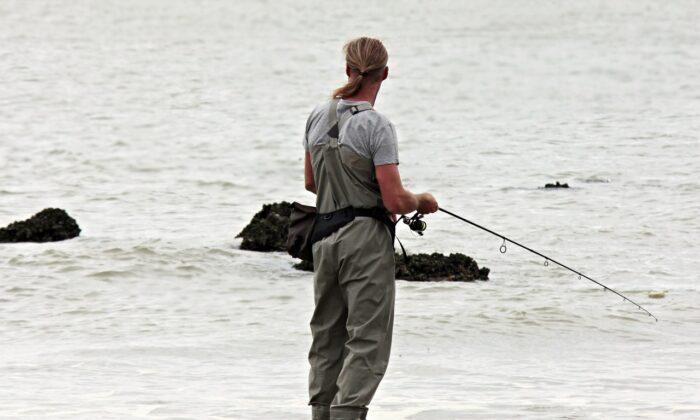Destruction of habitat and change in the migratory patterns of fish caused by electromagnetic fields (EMFs) emitting from offshore wind turbine cables will demolish the recreational fishing industry along the Atlantic coast, local fishermen warn.
Jim Hutchinson, the managing editor of the New Jersey Delaware Bay Edition of The Fisherman magazine, has been collecting studies suggesting EMFs will affect fish and reporting that data to his subscribers and at community meetings.
“I want to follow the science as we’re told, but when I look at the science and these government reports, I’m told this is going to impact my coastal fisheries, and yet nobody seems to be doing anything about it,” Mr. Hutchinson told The Epoch Times.
“In the extreme case, the cable could act as a barrier to the migration of fish, especially for species that use the Earth’s magnetic field for navigation and orientation,” the study reports.
The flounder was one of the species of fish named in the study in which there was a “significant correlation” between it and the EMFs.
“Flounder primarily crossed the cable when the strength of the electromagnetic fields was estimated to be low, i.e., during calm periods,” the study reported.
Overall, the study says EMFs affect fish, but steps back from the conclusion, stating the analysis is limited.
For example, it asserts that the migration patterns of some species are impaired while simultaneously asserting that “the cause-effect relationship remains unclear,” suggesting that there may be other explanations.
Mr. Hutchinson called flounder “the straw that stirs the drink” in the New Jersey region.
“Our fluke fishery is by far the number one most important recreational fishery at the Jersey shore, so as I look at this data, I started to wonder about how high-powered undersea cables from these industrial offshore wind sites might impact the inshore-offshore migration of summer flounder,” Mr. Hutchinson said.

‘Negative Socioeconomic Impacts’
Another study published by the National Oceanic and Atmospheric Administration (NOAA) titled “Fisheries and Offshore Wind Interactions: Synthesis of Science (pdf),” says it’s unclear what impact EMFs will have on fish behavior and fisheries.“The lack of knowledge on the intensities of EMF anticipated from the OSW [offshore wind energy] cables makes it difficult to draw conclusions based on the studies to date,” NOAA reports.
Skates, rays, and sturgeons, the study says, are most receptive to EMFs and, therefore, more likely to see impacts.
The study acknowledges the threat to fisheries if the industrialization of the waters interferes with the fishing industry.
“Any impacts of EMF on the availability of species may result in negative socioeconomic impacts to the fishing industry if they cannot safely harvest species attracted to turbines, cables, and the associated scour/mattress protection methods due to the risk posed by gear hanging up,” the study says.
NOAA admits that the disruption of survey programs and the assessments on which they depend will result in a collision between offshore wind development and fishery stakeholders.
“These impacts will lead to greater uncertainty in abundance estimates, which will likely lead to lower fishery quotas and lost revenue to commercial and recreational fishermen,” the report states.

‘Devastating to Recreational Fishing’
A July study (pdf) by NOAA found that its own surveys designed for the Northeast U.S. continental shelf (NES) ecosystem wouldn’t be able to produce information at a pace with development that could mitigate the reduction in fish population and potential destruction of habitat.According to NOAA, the NES is one of the most studied ecosystems in the world, and the 14 scientific surveys that NOAA has conducted since the ‘60s will be hindered by wind development.
“These surveys support management of more than 40 fisheries, more than 30 marine mammal species, and 14 threatened and endangered species through stock assessment and the provision of management advice,” the study said.
Offshore wind development will disrupt NOAA’s data collection, creating “spatial and temporal gaps” in information, the study said.
Blaming Overfishing
In addition to establishing control over U.S. waters, the Magnuson-Stevens Act (MSA) regulates fisheries to ensure fish populations stay at sustainable levels.In a previous interview, Meghan Lapp, a representative for a commercial fishing company in Rhode, Island, said that the fishing industry is the seventh most regulated industry in the nation, more regulated than the pharmaceutical industry and oil and gas extraction.
“We are not free to go where we want when we want and catch what we want,” Ms. Lapp said. “As a result, the ocean is a very small place.”
According to Mr. Hutchinson, because NOAA won’t be able to get an accurate survey of how wind development is reducing the fish population, the fishing industry will pay the price.
“If NOAA says there are 30 percent fewer fluke or summer flounder, that means fishermen have to be reduced by 30 percent, otherwise there would be an overfished population,” Mr. Hutchinson said. “So, what the Magnuson Act does is it triggers an overfishing definition.”
When summer flounder migrate elsewhere because of wind development, there will be a loss in population that will be blamed on overfishing, Mr. Hutchinson said.
Increase Of Whale Deaths
It’s not unlike what is currently taking place with whales washing ashore along the Atlantic coast, Mr. Hutchinson said.NOAA has stated the deaths are caused by human interaction such as vessel strikes, claiming there’s no evidence they are related to offshore seismic surveying.
“Look, I don’t know how industrial wind surveys are impacting whales or if they’re interrupting their ability to communicate to avoid hazards, but if you go back six to seven years, NOAA gave these folks permits to harass these whales, so they acknowledged they’re going to have an impact,” Mr. Hutchinson said. “Now, these whales start washing up on the beach, but NOAA is saying they aren’t connected.”
The correlation is hard to ignore, Mr. Hutchinson said, and it doesn’t bode well for how NOAA will report why there’s a reduction in fish population in the future.
“They’re supposed to be a science-based government agency, but they’re not using science, and that’s really scary,” Mr. Hutchinson said.

‘Outpacing The Speed Of Science’
Greg Cudnik, a recreational fishing for-hire captain in Barnegat Light, New Jersey, shared Mr. Hutchinson’s concerns, among others, such as the destruction of habitat during construction, the navigational issues the monopoles will present once raised, and the overall loss of a pristine landscape that will be mangled by the development.Both Mr. Hutchinson, Mr. Cudnik, and recreational and commercial fishermen face a future of multiple wind projects totaling 3,500 wind turbines along 2.4 million acres of the Atlantic coast, with 5.7 million more acres in planning.
This will include 10,000 miles of cable running along the ocean floor and onto the beaches that connect the turbines to up to 50 onshore substations reaching 30 stories high.
Tax credits found in the Biden administration’s Inflation Reduction Act have triggered a race for overseas companies to build turbines in coastal waters.
On paper, the initiative is to achieve carbon neutrality by 2030; however, those who are against rapid offshore turbine development say it’s about cashing in on the incentives before the consequences come to light.
“The speed with which developers and politicians are pushing offshore wind is exponentially outpacing the speed of science and the needs of the sea,” Cudnik said.
Like Mr. Hutchinson, Mr. Cudnik foresees the destruction of an ecosystem that will demolish the commercial and recreational fishing industry while the general public—as well as the developers—fails to grasp the magnitude of the industrialization project.
“I talk to people every day in the fishing community, and I estimate out of 100 percent, I would say a quarter to a third don’t even know what’s coming,” Mr. Cudnik said. “Well more than half of those who don’t know what’s coming are not in favor, and those who are in favor don’t know the full of extent of what’s happening.”






